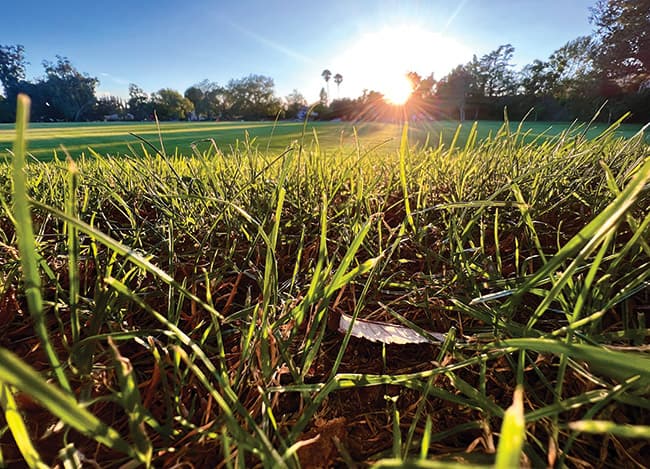A balancing act: Keeping Claremont’s drought-choked parks green

by Andrew Alonzo | aalonzo@claremont-courier.com
Every week, Claremont Community Services Director Jeremy Swan takes a stroll around one of the city’s 20 public parks to ensure one thing: that their greenery hasn’t faded away.
Due to the ongoing drought and concerns over water usage, in May the Claremont City Council voted to “reaffirm the critical water shortage facing the region.” A month later, Golden State Water and the city implemented strict regulations that would have residents reduce their water usage by 20 percent. To read about the restrictions, visit claremont-courier.com.
The move forced Swan and his staff to rethink how they would keep the City of Trees’ parks green. Now more than two months into the new rationing rules, Swan gave the COURIER an update on the parks’ status.
“There has been some browning of certain areas in some of the parks,” Swan said. “A lot of that has to do with irrigation concerns that we’ve been working to fix.
“If we have an irrigation break, either a main line or anything, the park may be down for about a week or so because we’re having to turn the water off [and] get it fixed. We’ve had that happen in a couple of our parks, but then we’re going to push water back in those areas to not have the grass turn brown.”
The city has also turned off the water fountains at Claremont Village Plaza and near Padua Hills.
Twenty parks span the 13.47 square-mile area of Claremont. They include Blaisdell, Cahuilla, Chaparral, Claremont Hills Wilderness, College, El Barrio, Griffith, Higginbotham, Jaeger, June Vail, La Puerta, Larkin, Lewis, Mallows, Memorial, Padua Avenue, Rancho San Jose, Rosa Torrez, and Shelton parks. Higginbotham’s Sycamore Canyon is counted as its own park by the city.
The parks hold not only a great portion of the City of Trees’ trees but also generations of sentiment, and amenities for locals. Youth soccer games and other sports and the city’s annual summer series of movies and concerts are all held there.
“We’re a small community, but we have a very active park system,” Swan said. “Citizens and the community members love the parks. They love to get outdoors and visit the parks to be active. If the parks are not maintained, then people aren’t going to want to go there and they’re going to find something else to do.”
Unease over park browning has been on the minds of Swan and his colleagues ever since the new restrictions came into play.
“There’s always a worry or concern because once it hits that [brown point], what are we able to do to bring them back?” Swan said. “I call it the razor’s edge of balancing browning; how can we maintain everything with the least amount of water?”
The good news from Swan is that during recent walks, none of parks around the city had gotten to the level of browning seen in the drought of 2015. But current restrictions have him thinking about how to prevent a similar fate.
“You need to maintain a certain level of water for the urban forest and if you don’t, we run the risk of losing trees,” Swan said. “And if we do lose a 50, 60-year-old tree because it doesn’t receive [enough] water, us planting a 15-gallon tree is not going to replace the carbon emissions in the urban environment.”
Claremont residents appear to be playing their part in reducing water usage. In June 2022, Claremonters cut water consumption by 45% when compared to June 2021, according to city councilmember Jennifer Stark, who is also vice chair of the San Gabriel Valley Council of Governments’ Water Policy Committee.
With the drought raging, there is no end in sight for rationing in Claremont.
“If the [20% usage reduction] number is maintained, I believe that we’re still staying with the one day a week watering and everything like that,” Swan said. “If the numbers do not maintain, it could even get worse. But my understanding is we’re kind of staying with it.”
Over the last five years, the city has updated a few parks, Lewis, Cahuilla and Blaisdell among them, with drought tolerant landscaping designed to help reduce water usage. Swan hopes to outfit other city parks with similarly drought friendly plants through Metropolitan Water District rebates and other means.
“The importance [of green parks] overall is it is a welcoming environment,” Swan said. “If you go to the park and you see them brown, it’s like they’re not being taken care of. We really want that welcoming and warm feeling of coming to the park. It’s comfortable, it’s being well maintained, and having that green grass is what we really care about.”
In a town appropriately dubbed the City of Trees, parks help make Claremont, Claremont. They act as a social hub, where families and friends congregate.
“Parks can make or break the community,” Swan said. “If you don’t have a park or you don’t have the area for people to congregate, where are they going to go? Parks are vital to the community. The parks are part of what make Claremont special.”
For more information on city parks, visit ci.claremont.ca.us.









0 Comments